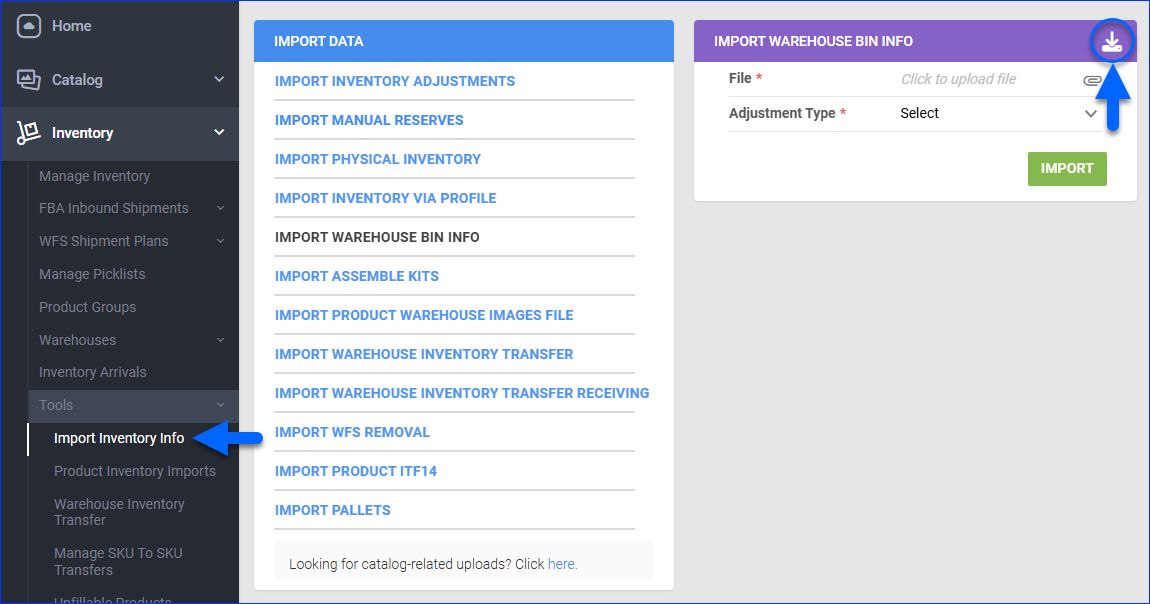Overview
When transferring inventory between different warehouse locations, moving stock within your facility, or consolidating inventory from various sources, you may need to import new inventory counts, adjustments, or transfer requests. The Import Inventory Info page in Sellercloud enables you to easily import this information for multiple products simultaneously using predefined templates, eliminating the need to enter each one individually. This process ensures efficient and accurate inventory tracking. Additionally, you can quickly assemble kits, upload warehouse images, import ITF-14 barcodes, build pallets, and more.
Import Inventory Info
To import inventory information:
- Go to Inventory > Tools > Import Inventory Info.
- Choose an import option in the Import Data panel. See a list of the available options below.
- Click the Download icon to download a template file in Excel, CSV, or TXT (tab-delimited) format.

- Populate the file columns with the relevant data and save it.
- Based on the import type you want to perform, return to the grid and import the file.
Import Types
Below are the import types available in Sellercloud, along with their definitions:
- Import Inventory Adjustments – Adjust the quantity of your products in non-bin-enabled warehouses to address discrepancies. For example, when miscounts occur or an item is damaged, you can enter -1 to decrease the count. Similarly, if you discover additional inventory that is not recorded, increase the quantity accordingly to reflect the actual stock.
This option is currently limited to warehouses that are not Bin-Enabled. To adjust the physical inventory count in bin-enabled warehouses, use the Basic Product Bin Adjustment option of the Import Warehouse Bin Info feature.
- Import Manual Reserves – Set product inventory reserves aside for certain channels or customers in bulk. Inventory reserves have a specific quantity and are active for a selected time. While active, the reserved amount is deducted from the sellable inventory and exclusively set aside for the specific channel or customer. Any new orders from that channel or customer will be deducted from the reserved amount first.
- Import Physical Inventory – By setting physical inventory, you specify the total quantity of a product in a specific warehouse. Once you know the precise count of product units in stock, you can set the physical inventory in bulk to ensure your inventory quantities are accurate and up-to-date.
This option is currently limited to warehouses that are not Bin-Enabled. To set a physical inventory count for bin-enabled warehouses, use the Initial Product Bin Adjustment option of the Import Warehouse Bin Info feature. - Import Inventory Via Profile – Bulk-update the physical inventory quantity of your products per warehouse through a custom inventory profile. Custom inventory import profiles let you import Excel, CSV, or tab-delimited files with column headers that are not the same as the standard Sellercloud fields. This way, you can bring external information into Sellercloud without the need to manually reformat the data. Learn more about Inventory Profiles.
- Import Warehouse Bin Info – Set the initial product inventory count per bin or adjust the current bin quantities for multiple SKUs simultaneously. If your bin quantities are maintained in a system external to Sellercloud, this is an easy way to bulk-update inventory quantities in Sellercloud.
- Import Assemble Kits – Assemble Independent Kits in bulk to distribute the inventory of the individual components into the parent products.
- Import Product Warehouse Images File – Import product warehouse images in bulk directly from publicly accessible URLs. These images can help Skustack users locate and identify products within warehouses.
- Import Warehouse Inventory Transfer – Create Warehouse Inventory Transfers (WITR) with a Pending status in bulk. This feature can be useful anytime you physically reposition inventory, such as when balancing stock levels, meeting seasonal demand, expanding your operations, or optimizing space.
- Import Warehouse Inventory Transfer Receiving – When products you are transferring between warehouses arrive at their destination, you can use this import option to mark the inventory as received in bulk.
This import option is currently limited to warehouses that are not Bin-Enabled. To learn more about receiving inventory transfers in bin-enabled warehouses, refer to Skustack’s Warehouse To Warehouse Transfer. - Import WFS Removal – The Walmart Fulfillment Services (WFS) program allows you to return some of your inventory from Walmart’s fulfillment centers back to your local warehouse due to product recalls or other issues. You complete this process through WFS Removal Orders. While the removal process is managed directly on Walmart, you can import this information into Sellercloud in bulk to maintain accurate inventory levels.
- Import Product ITF14 – Bulk-import ITF-14 barcodes for your products. ITF-14 barcodes are commonly used for cartons, cases, or pallets of products, serving as a unique identifier to track products at the package level. The barcode includes a unique 14-digit ID, the product’s UPC, and its quantity in the package.
- Import Pallets – Pallets are a base for assembling, storing, and transporting goods within a warehouse or during shipment. They enable you to stack and handle multiple products as a single unit. You can bulk import pallets and scan them with Skustack during various activities, such as bin-to-bin transfers and receiving POs.